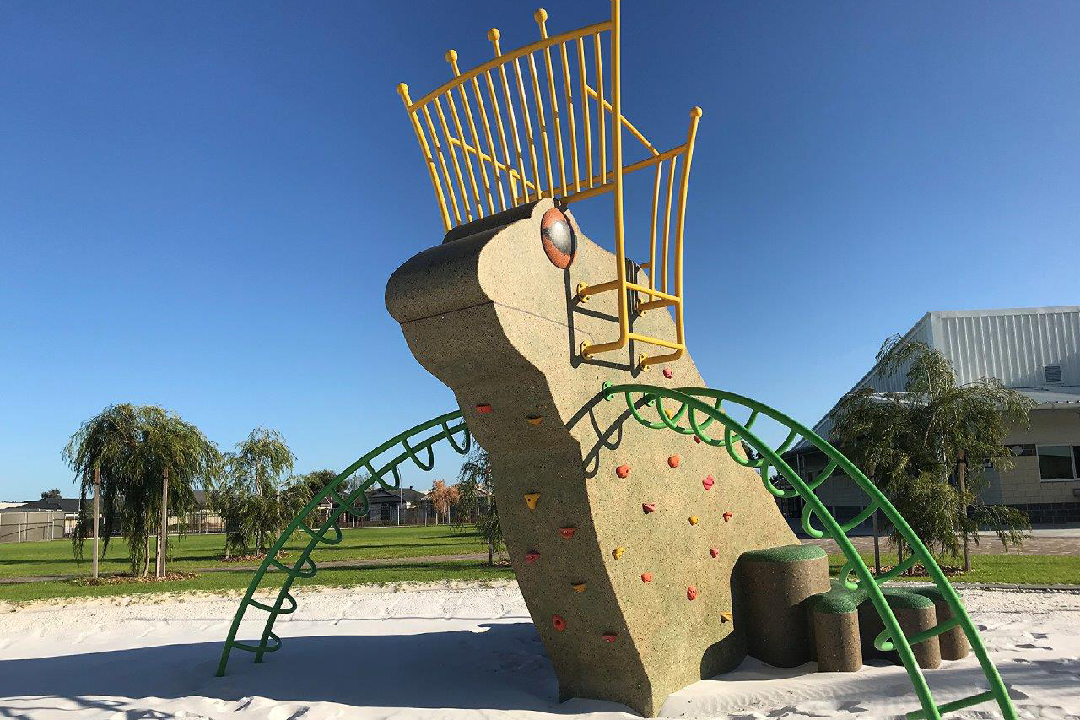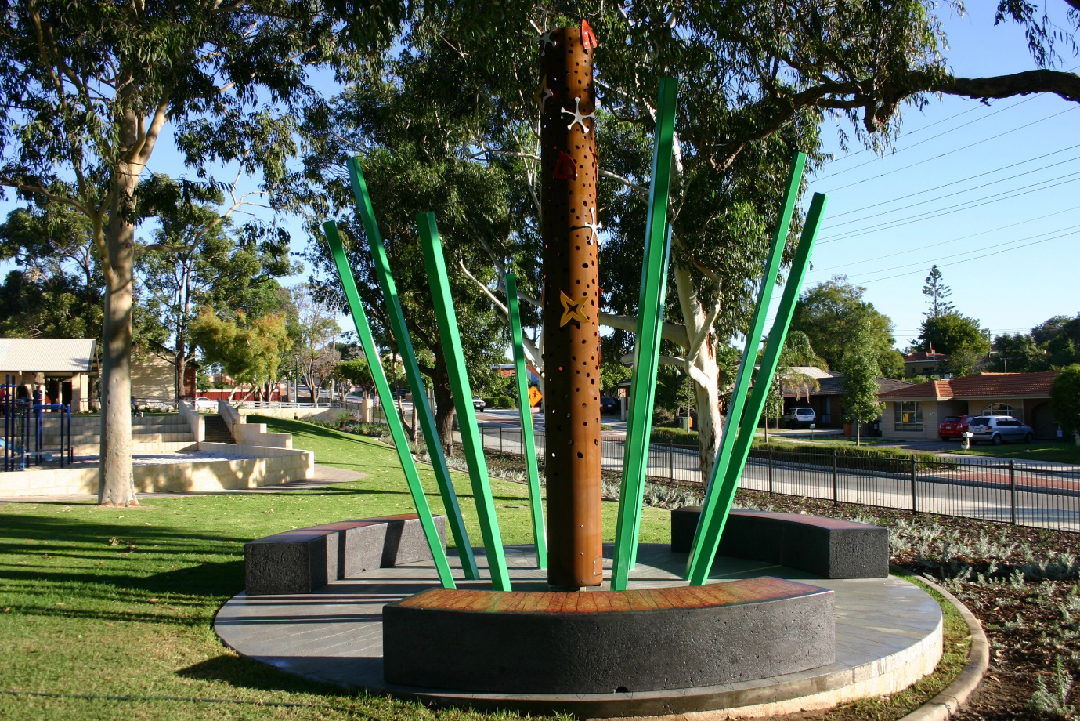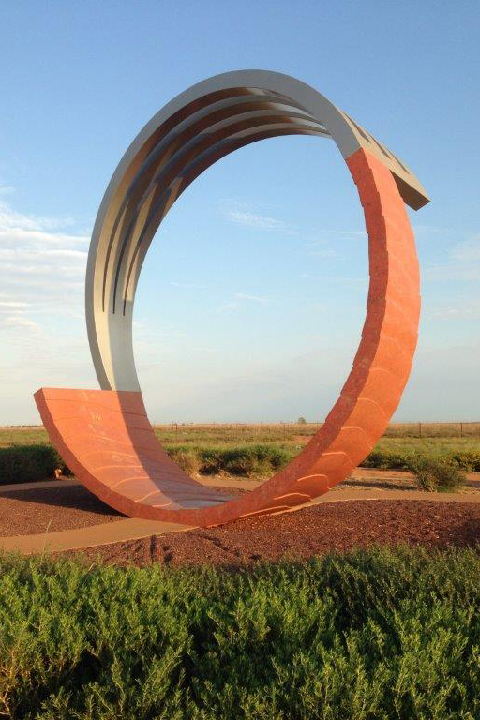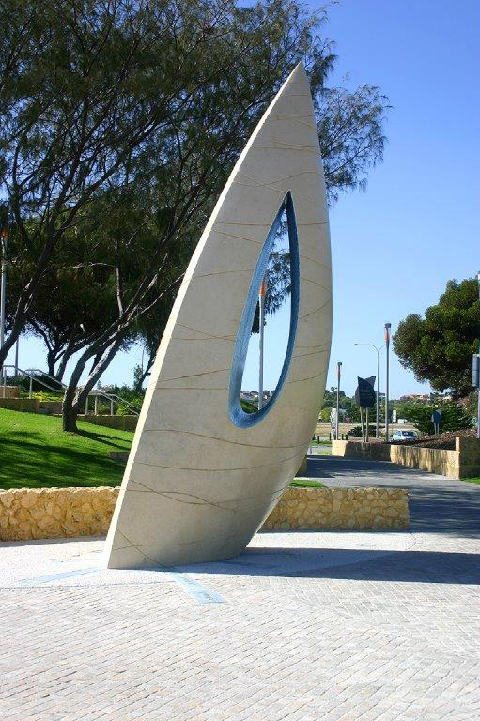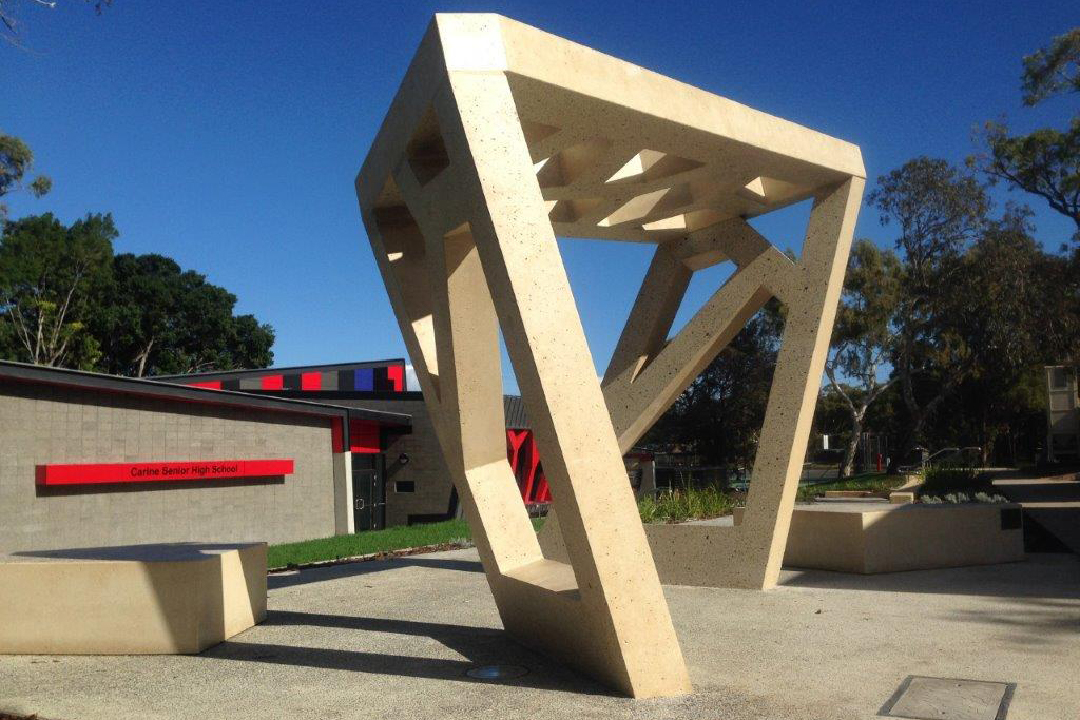Jahne Rees
Scape-ism
Caversham Valley Primary School Percent For Art Commission 2019
Kooyar, the Motorbike Frog
This project represented an ambitious approach of bringing the public artwork into the play space as art and non-original playgrounds. The central idea of the artwork is a frog riding a motorbike. As it was designed as an active play structure, a lot of consideration has been dedicated to its functionality, and is therefore somewhat deconstructed into three main elements, the main body of the frog, the motorbike handlebars, and the front tyre of the motorbike. It also Features a couple of QR Code plaques, which relay stories of the frog from local Nyoongar Elders, Neville Collard and Herbie Bropho.
The primary function of the frog is a slide. Made of polished concrete, the body of the frog stands at 2500mm high. It is supported by a pair of polished concrete back legs. The concrete surfaces feature coloured designs referencing the incredible array of colours and patterns these frogs display.
The eyes are detailed polished concrete domes, the essential element in bringing this cheeky character to life. The front legs are made of powder-coated steel pipe. They are designed as the main climbing route to the top of the slide, just behind the frog’s head.
For the more adventurous, the other way up is via a series of climbing grips, fixed to the concrete body. This frog king also wears a crown, which doubles as a safety barrier, preventing access to the nose of the frog and directing the flow down the slide. This is also made of powder-coated steel pipe. The whole structure can accommodate numerous children climbing over it at any one time. It encourages a range of sensory responses and physical challenges.
The handlebars essentially function as a swing. The rear supports are the forearms of the frog, which rise up from the buried elbows to reach the hand grips at a maximum height of around 3000mm. They are however non-climbable to prevent any unintended access to the top of the swing. The fingers wrap around the hand grips, and complete the illusion of the frog riding this chopper, hanging onto the “ape hanger” handle-bars. The swing is a proprietary nest swing, which can accommodate several children at once.
The final element is the front wheel, an oversized recycled rubber tyre from a haul-pack mining truck. At approximately 2500mm diameter, the tyre is buried half-way in the ground. The intention is for kids to be able to climb over, under and through it.
All structures and elements of this design meet the Australian Standards for playgrounds AS 4685.
Lake Gwelup Primary School Public Art Commission 2012
with Rob McCulloch
This project presented a cohesive family of interactive works that appear at various locations around the school. As it was an existing school being re-developed, there was a long and varied history associated with the area. We addressed themes of Aboriginal co-existence with the environment, as well as European Market gardening heritage. The first of the artworks is a large Entry Statement, which is an investigation and celebration of the Grass Tree, the School’s logo. We chose this amazing plant not only because of its many useful qualities that were particularly valuable to traditional aboriginal people, but also because of its incredible resilience to the effects of time and bushfire. The Grass Tree is a strong symbol of renewal and new growth, a metaphor for the redevelopment of the school. The artwork is not a literal representation of the grass tree, but an investigation into aspects of its life cycle and qualities of different parts of the plant, a deconstruction if you will. The intention was to engage kids in their own experience of interpreting both the artwork and the plants themselves. Various elements of the work included a 5m rusted Corten steel column as the central spear, which was adorned with colourful painted aluminium abstract flowers and plasma-cut designs. Surrounding this was a series of bright green grass tree stalks, made of painted steel square tube. These represent the new growth that emerges from the top of the burnt stump after a bushfire. The concrete base pad, 6m in diameter, features a cut design referencing the spiralling diamond pattern of the plant’s growth structure. Sitting further out on the circle is a set of three colourful polished concrete seats that represent segments of the grass tree trunk.
Other locations around the school feature more grass tree stalks, in combination with polished concrete seats which reference various fruit and vegies from the market gardening era. The students participated in workshops, cutting up and drawing market produce as a resource for these artworks. Linking all of the works around the school is a meandering trail of concrete pavers, featuring artwork designed by the students which investigates the rich history of the area and a connection with the natural environment.
Port Hedland Entry Statement 2009
“Transformation”
This artwork is an iconic and emblematic monument to Port Hedland, reflecting the essence of Pilbara life. Standing at 8m high, it is made of reinforced polished concrete and industrial-coated steel. The use of these contrasting materials references the transformation from raw iron ore to processed steel. The concrete element represents the red earth and minerals of the Pilbara, and includes a content of iron ore aggregate. It features the contour lines found on a topographical map or in the gorge-like valley of an open-cut mine. In stark contrast, the steel element has a sleek shiny surface with a modern industrial aesthetic. It represents the ongoing refining of technology and materials, as well as humanity’s striving achievement. It presents a fluid forward-surging movement of speed and progress into the future. The hard-edged shadows cast by the steel section onto the lower half of the ring, further highlight the contrast in the nature of the two materials and their shapes. These two forms are linked and intertwine in what appears to be a continuous revolving wheel, from the earth to the processed material, and back again.
This work symbolizes aspects of the area’s history and present day character, its contrasts and duality: The coexistence of Indigenous and non-indigenous cultures, the meeting of ocean and earth, the delicate balance between environment and industry, the raw material contrasted to the processed, the contrast of landscape and the built form, of culture and land use, of the ancient and the new.
The inner surface of the concrete curve is embellished with a series of small recessed motifs that meander across the surface like a dry riverbed. These are a collection of symbols referencing various aspects of Pilbara ecology, history and culture. These motifs are subtle, like footprints in the sand. They document the passing of life, and its tenuous struggle to survive in this harsh environment. They are contrasted not only to the futuristic steel form above, but also to the modified landscape they traverse, and remind us of the delicate balance of life, both past and present.
This artwork stands both as an heroic symbol of humanity’s endeavour and progress in a harsh and adverse environment, as well as pays homage to the resilience, beauty and fragility of local ecosystems that have sustained life for thousands of years. The work was commissioned by the Town of Port Hedland, and was installed on The Great Northern Highway close to the Port Hedland airport. The project involved significant collaboration with various stakeholders in Port Hedland including BHP Billiton, Cultural development officer, landscape architect, local contractors, structural engineer and lifting design engineer. The concrete element of the sculpture was built by Jahne Rees and Liam Cole in our Beaconsfield workshop, the steel element was built by C-Tech Engineering in O’Conner, and all transported together and erected on site by The Freo Group. The overall budget was $172,000 plus GST.
Kalbarri District High School
Percent for Art Commission 2007
There are three major components to this project. Each artwork employs the central motif, “where the land meets the sea”, and is based on an interlocking spiral design. The first piece is a freestanding entry statement sculpture. It consists of two separate parts. The base is made of reinforced limestone concrete, ground to a smooth terrazzo finish. It features seashells and local aggregate and sand in the mix. This supports an aluminium structure above it, which is exactly the same shape as the base, but held in the inverse position, locks perfectly into it. The upper piece is made of 6mm marine grade aluminium plate, which was rolled and welded into a spiral form. It features cut out fluid shapes, reminiscent of a nautilus shell. The finished piece stands at a height of 2.2m and is a central focal point of the external space at the entry to the school.
The second component to this project is a series of hexagonal concrete paving blocks, each bearing the same tessellating interlocking spiral motif. One half is a limestone mix with shells and rainbow quartz. The other half is blue metal and pea gravel aggregate with a dark blue oxide. They have been ground to a coarse terrazzo finish to expose the aggregate. When arranged together these pavers form a variety of different tessellating designs. They have been set into the surrounding concrete pavement and appear in various clusters and arrangements throughout the school. Each paver is about 500mm across and there are 70 of them in total.
The third part of the project involved primary students from the school in the creation of two large interlocking concrete seats. Each one is 500mm high, 6m long, and they function as seating for spectators alongside the basketball courts. They’re exactly the same shape, but one takes on the form of a leaf, and the other, a fish, representing both land and sea. The students designed numerous symbolic motifs, which were integrated into the upper surface as terrazzo inserts. The whole surface was then ground and polished smooth to reveal the kids’ colourful artwork, which has resulted in much pride and joy amongst them. This project involved significant collaboration and coordination with the architect, builder, school staff and students. The overall budget for this project was $62,000 plus GST.
Hillarys Boat Harbour Public Artwork
Percent for Art Commission 2007
This work is a 6m high organic shaped abstract freestanding sculpture made of reinforced concrete. It is a singular monolithic form, an iconic landmark, highly visible from all over the boat harbour. The design draws inspiration from the marine environment, both natural and man-made forms. It references the foil shapes and flow dynamics of sails and boat hulls, as well as those of fish and other sea creatures. The outer surface is a mix of crushed limestone concrete and shells, which has been ground and polished to a smooth terrazzo finish. The work features an internal open hollow section that cuts right through the form, creating a kind of internal window. Its shape follows the lines of the main foil-like form and suggests the kind of open space that exists between the two sails of a yacht. The internal surfaces of this window section are lined with mosaic tiles, creating a kind of speckled tapestry of blue, the colour of the sea or the sky. This artwork required significant engineering, and having been built partly on site, involved a good deal of co-ordination with the landscape architect, engineer and building contractor. Set into the concrete around the base of the sculpture, sits a terrazzo wind rose, representing average local wind direction and speed over the year. This features some interpretive brass text, explaining how to read a wind rose. The budget for this project was $88,500 plus GST.
Tapping Primary School
Percent for Art Commission 2006
The brief for this project called for an interactive artwork, which essentially became a whole sculptural playground. It consists of a series of concrete and rammed earth structures that represent various physical features of the natural environment, the coastal strip, from ocean to wetlands. Each piece has its own unique form, inviting children to climb on, through or over them, as well as encouraging further inquiry and imaginative play. The surfaces of the works are ground to a smooth terrazzo finish, and feature colourful motifs representing local flora and fauna. As the artwork is essentially a playground, it had to conform to the Australian Standards, and an independent assessment was sought to ensure that it did. Items such as the hand railing for the slide piece and rubber soft fall material presented particular challenges, and also provided many insights for future projects. The finished work has been very well received by staff and students, as well as the local skateboarders. The budget for the project was $69,000 plus GST.
Carine Senior High School
‘Gateway Unwrapped’ Percent for Art Commission 2014
Originally inspired by aspects of the adjoining architecture, this Entry Statement sculpture and subsequent works was a very complex project. It involved complicated engineering and logistics details, and coordinated collaboration between the architect, builder and artist was essential to its success. The work is essentially a polished concrete archway, made up of three panels, which is accompanied by two separate seating pieces. The arch structure is made of 250mm thick 40 MPA concrete panels, with a smooth off form finish. It stands at a maximum height of 3.5m. The roof panel is 4.3m x 1.7m. The narrowest point between the panels is 2m at ground level, providing good disabled access. The two seating pieces sit at 450mm high and are up to 1.8m long. They represent the missing cut-out pieces of the wall panels, as if they have simply fallen out. The interplay between the built form and the artwork was a true symbiotic relationship, as aspects of the sculpture design were taken back into the architecture as seating, picking up on the interchange of positive and negative space.
Brighton Plaza Artwork
Swimming in the Shade of Days Going By
with Rob McCulloch, Commissioned by The City of Mandurah 2012
This artwork celebrates the history and captures the essence of the ongoing human connection with the Mandurah area. The movement of water, as the central theme, has been used to highlight aspects of Mandurah’s history and culture, referencing fishing and recreation in this traditional meeting place, as well as life cycles of estuarine life and the delicate balance of coexistence.
The work consists of a long meandering series of Jarrah bush poles, which support a ribbon-like fluid form, made of perforated aluminium panels. The whole structure is over 20m long, and traverses the plaza, linking the various areas and creating a strong cohesive presence and identity. It covers a significant area of the space without imposing a large footprint. It is designed to encourage pedestrians to divert their route and engage further with the artwork and indeed the whole plaza.
The timber poles are reminiscent of old weathered jetty or bridge poles. They also reference various aspects of the area’s history, such as traditional Aboriginal fish traps, or old fence lines disappearing into the estuary. The aluminium element can be seen as the life force of the artwork, the streaming flow of the Murray River. It features swirling schools of mullet and herring among other estuarine creatures and plant life. These images are comprised of tiny round perforations of various sizes, which alternate to form both positive and negative images, depending on the time of day. The resulting play of light and shadow cast through the perforations and onto the ground add an extra three dimensional experience to the work, and a sense that we are immersed in the underwater realm of the creatures depicted.
This has been a very ambitious project involving new technologies, including on-site 3D scanning and computer modelling, together with a rigorous fabrication process, to realize this highly complex and precise structure.
Coogee Heritage Marker Project
City of Cockburn 2006
This commission involved the design and construction of nine separate markers located at various points of significance around Coogee. Each piece is essentially a 3m high limestone plinth, which supports a rusted forged steel sculpture, representing some cultural or historical interpretation of each location. The stonework consists of limestone rubble rocks, laid to create the appearance of a dry-stone wall, which, in combination with the rusted steel, references the qualities of early colonial building materials and techniques. Each piece features an interpretive panel, bearing historical photos and explanatory text. These are on aluminium, using an anodising printing process, which is UV and graffiti resistant. The total budget for the project was $58,000 plus GST.

